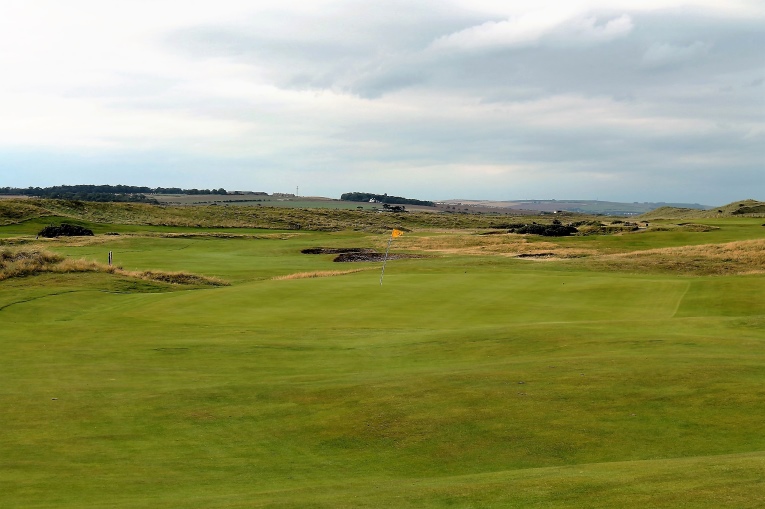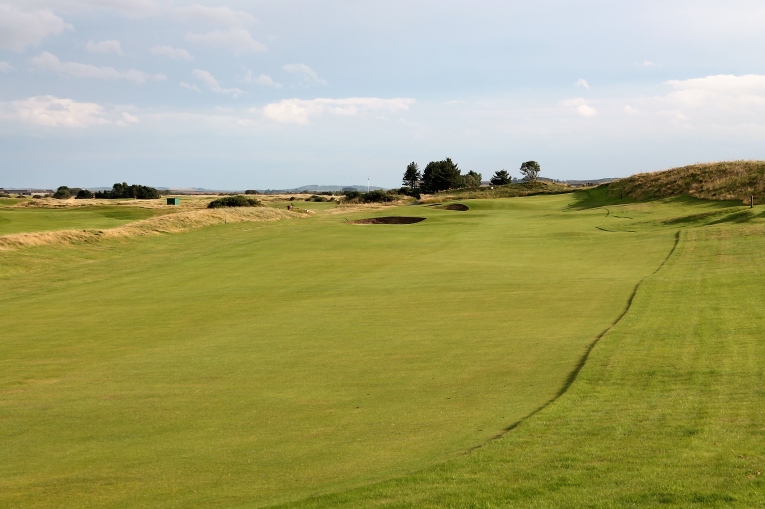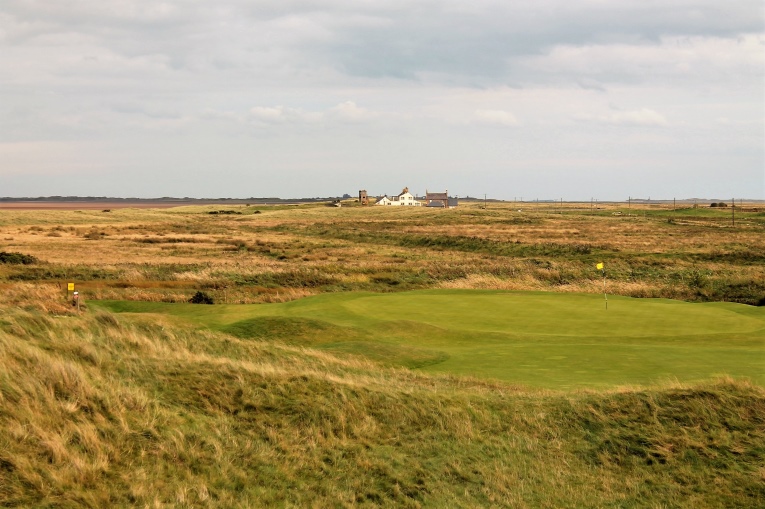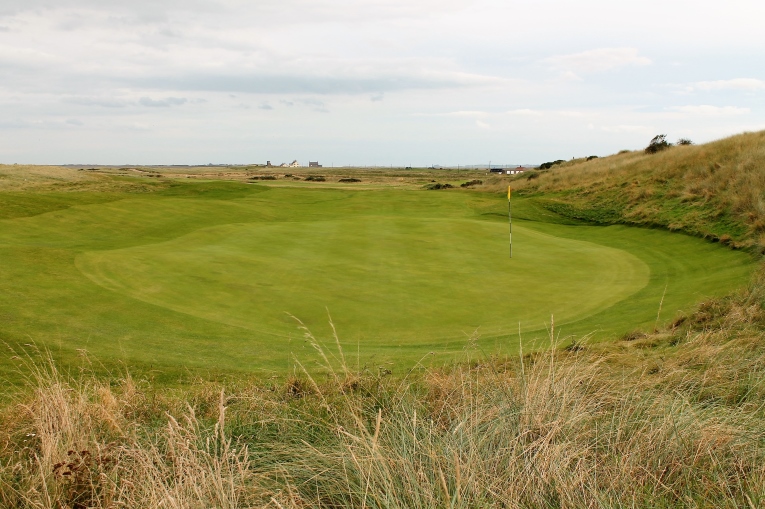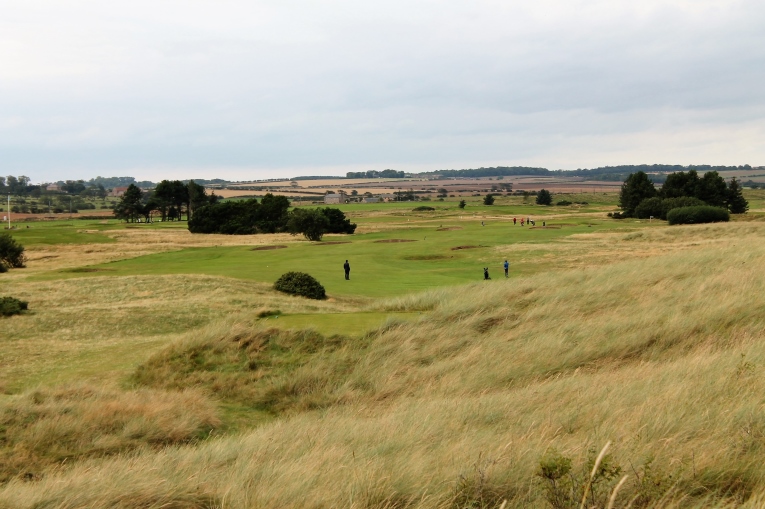Goswick Golf Club
Berwick-upon-Tweed, England
United Kingdom
Who would dare argue with the charm of playing out and returning back to town? The Old Course at St. Andrews and North Berwick have long been the template for such a delightful journey. And yet … when you start and end in town, it’s unlikely that the opening and closing holes can be expanded. Witness the 322 yard opener and 277 yard closer at North Berwick – fifty miles north and across the border from Goswick Golf Club. Conversely, build a course away from town in a more remote setting and the club is likely to enjoy far more flexibility moving forward. Such is the happy case of Goswick Golf Club, who took upwards of eighty years to round into its present form. Its patient evolution makes for great study. Bill McCreath wrote the club’s centennial book One Hundred Years of Golf at Goswick, which proved so popular as to now be elusive. It eloquently documents club events from 1889 to 1989. His son Ian graciously shares with us his father’s research:
A well-known North Berwick golfer, Tom Dunn, was invited to look at two potential sites for a golf course in 1889 in the Berwick, namely Goswick and the Magdalene Fields. Mr. Dunn recommended Goswick, because it was “the proper kind of ground”, and creating a course at the Magadalene Fields in the town itself would be hampered by the need to cut the grass. “Even if they had a man continually going over the ground with a cutting machine, they could not put it into a good playing condition for golf.” Of course, a course was created at the Magdalene Fields in the early 1900’s. It does not appear that anyone from outwith the Goswick Club was responsible for the original 9 hole layout, which opened for play on the 19th April 1890.
Dunn’s preferred location for Goswick was six miles south of the town of Berwick-upon-Tweed. The site was – and still is – buffered by farms to the west and Goswick beach and dunes to the east. Originally, golf was created at the south end of today’s course in the natural dune country marked by the 12th-14th holes. Ian McCreath adds, “To quote again from my father’s book, the course was extended northward into 18 holes in 1893/94. It seems the members would do most of the work of laying out the course, but my father records the following: ‘The new holes were planned by the professional at Ryton Golf Club, Mr R. Collins. He was paid £3.3.0d ‘for laying out the course.’ “
Ian continues the Goswick story: “Willie Fernie of Troon was asked to come and lay out the new holes (because of flooding at eight holes in the winter) in 1898 and superintended the work. In September 1903 Willie Park of Musselburgh came and inspected the course and made certain suggestions as to its rearrangement, his fee and rail fare being £6.6/-. The result was that the course was extended to 4,880 yards.”
Near the turn of the last century, Ben Sayer expanded North Berwick to include today’s 8-11 holes, pushing the course to over 6,000 yards. Relatively speaking, Goswick lacked distance to counteract the advent of the Haskell ball in the early 1900s. Indeed, Abe Mitchell played a famous match here in April, 1923 and was quoted in the Daily Express, “It struck me as being one of the comparatively few absolutely natural seaside courses in the country. The material is there to develop it into a really first-class natural course. The first thing, obviously, is to get more length. The course at present measures only about five thousand yards.”
If the course had been hemmed in and destined to measure in the 5,000 yard range, its ultimate place in the game would be different than what it became. In 1930 James Braid did a major overhaul of thirteen holes and lengthened the course considerably, pushing it past the 6,000 yard mark. The renowned player, Frank Pennik, took his turn in 1963 and materially improved the front nine. Today’s course measures over 6,800 yards with four healthy three-shotters and five two-shotters well over 400 yards. Many hugely appealing English country courses have been profiled on this web site, often by Sean Arble (for a complete list of his course reviews, click here) that play between 6,100 and 6,400 yards. Goswick shares their lure but has the added distance to boot that will test the golfer’s full repertoire of shots.
An obvious question is posed: In the process of adding nearly 2,000 yards over the past ninety-five years, did the course lose its charm? No. Indeed, golfers fortunate enough to play here often comment on the its primordial feeling. That begins with a 2.5 mile single lane road off the A1 that winds past working farms to the club. Other than an occasional passenger train whistling by on its way to Edinburgh, the golfer is left alone in peaceful seclusion. Surely, this is one of the world’s quietest environments in which to enjoy a game.
As for the golf itself, each nine enjoys its own flavor. The predominant feature of the front nine – and Pennick deserves the credit – is how many holes elbow or dogleg in one direction or the other. Beginning at the first and running through the eighth there is always something to accomplish off the tee. An ace player, Pennick loved to bend fairways, giving the golfer who can shape the ball both ways a decided advantage.
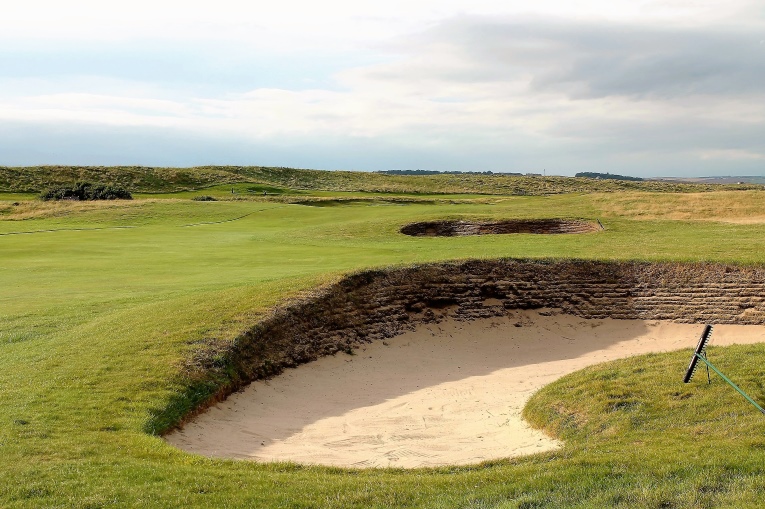
Well-placed, well-constructed bunkers like these protect the integrity of the dogleg right fourth hole and mete out an appropriate 1/2 shot penalty for imprudent tactics.
As for the back nine, it occupies the prime seaside land that Abe Mitchell raved about in 1923. Most of the golf is played to the west of a dominant dune but is happily extended east of it for the thirteenth and fourteenth holes. A counterclockwise loop formed by holes twelve to fifteen offers breathtaking views in all directions of Goswick farm and over the wide expanse of Goswick beach. Seclusion envelopes the golfer in a stirring, wonderful environment in which to enjoy the game.
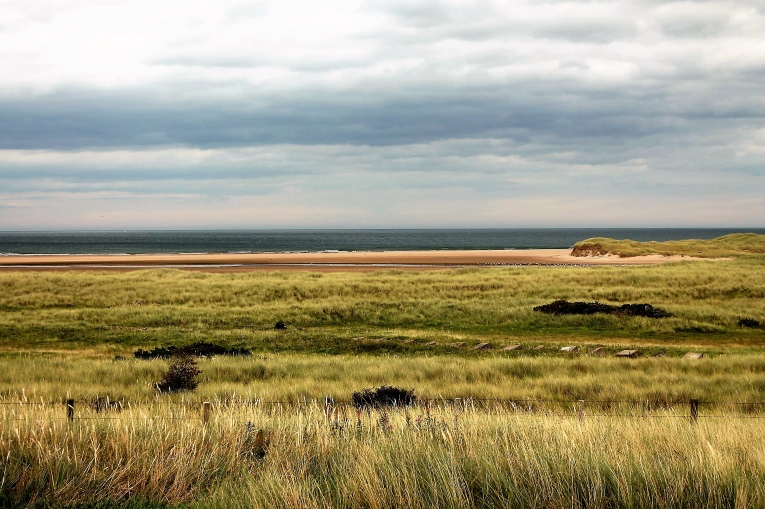
This magnificent view of Goswick beach is afforded from the back of the fifteenth tee. It is possible to trek northerly from beach to beach and ultimately reach North Berwick.
Though five architects can lay claim to significant credit for the course’s evolution, most importantly, today’s course feels like (with one exception) it was cut from one cloth. As we see below, you feel as though you are at the end of the earth, where man’s hand has done nothing to ruin the primal spirit that pervades these ancient, wind sweep dunes.
Holes to Note
Second hole, 165 yards, Crater; Well-named, the short second plays over – you guessed it – a crater. Both the tee and green occupy the high points of the front nine so this hole’s challenge/severity shifts with the weather.
Third hole, 435 yards, Shieling; While not flashy, the third is a well-conceived hole with the tension to hug the inside of the dogleg exacerbated by the right to left sloping ground near the green. The more often you play the third, the more you give it its proper due.
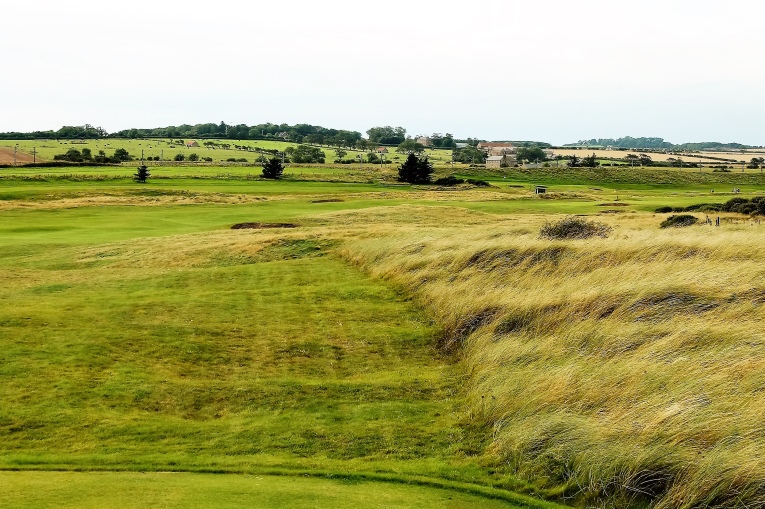
The third fairway pivots right at the bunker on the inside of the dogleg. Sand coupled with the rough means that greedy tactics off the tee are rarely rewarded. Prudence carries the day.
Fifth hole, 420 yards, Pennicks Way; Considered by some members as the best of the front, the hole elbows left as the fairway cambers right. The placement of the green with a hollow left and steep faced bunkers right is magical. Credit for this and the sixth hole lays with Frank Pennick, who moved the front nine much closer to the shore than it ever had been with the advent of these two holes.
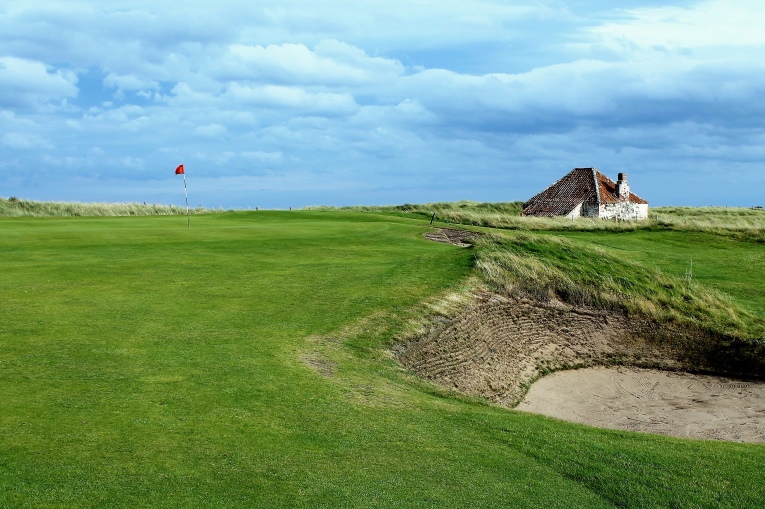
… short right in either steeped faced bunker muddles the golfer’s aspirations for a good score. The structure is a fishing shiel where net fishermen kept their nets and other equipment and is off club property.
Sixth hole, 530 yards, Cocklaw; This fine twisting three-shotter starts by hugging the club’s coastal perimeter, which is out of bounds right. Its fairway then dips into some fine dune country before jogging right and concluding at a green perfectly positioned atop a dune at the northern end of the property. One of the most disheartening shots is an approach that just ‘makes’ the putting surface, only to be whisked off the plateau green’s steep front 25 yards back down the hill.

Laying up less than 80 yards from the green invites all sorts of uneven stances and lies for one’s pitch.
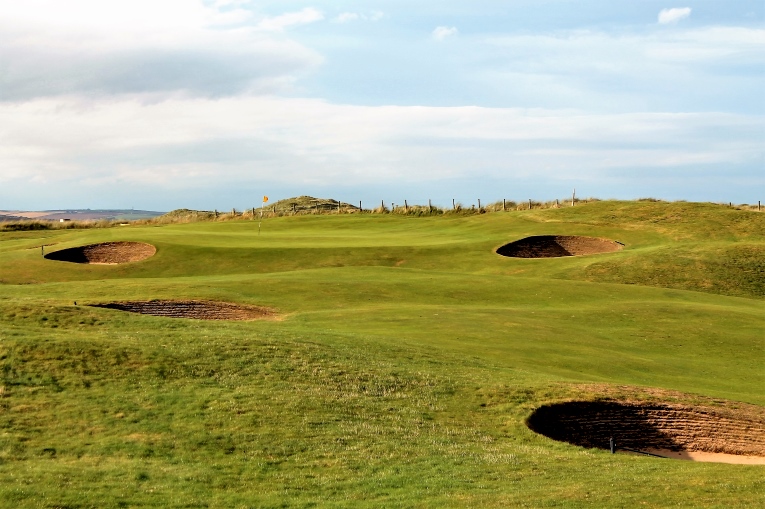
Front hole locations are often easier on two tiered greens but not here because of the threat posed by the false front.
Seventh hole, 390 yards, Valley; Apart from a burn on the back nine, the only linear aspect to the design is the hard right side of the seventh fairway. After having playing so many doglegs, the golfer may – or may not – be ready for such an abrupt shift. A well-placed fairway bunker on the left squeezes the effective driving zone 120 yards from the green and creates a conundrum of staying short or scooting past. Certainly, the day’s wind direction means much but it is nice to see how potent a solitary fairway bunker can be when positioned for maximum effect (virtually encased in fairway grass). With five bunkers standing sentinel along the left side of the green complex, the golfer is better served to hug the right with his tee ball.
Goswick Golf Club
Berwick-upon-Tweed, England
United Kingdom
Eighth hole, 420 yards, Cheswick; A nest of four revetted bunkers handsomely reside in the elbow’s crook at the last of front’s five doglegs. It takes a sturdy drive to have a decent view of the flag, let alone the green. With Goswick’s prevailing wind blowing out to sea, the man who can draw his tee ball around the dogleg has a decided advantage on this southerly facing hole.
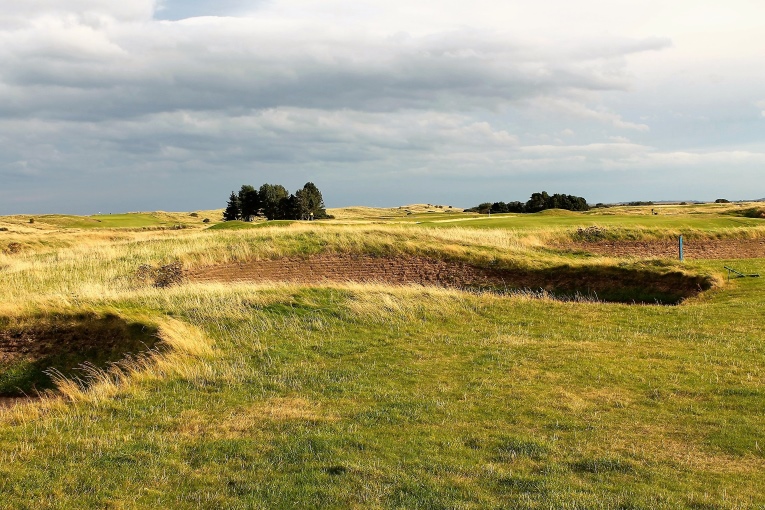
The fluttering yellow flag indicates the hole’s typical right to left breeze, the very conditions that love to shove one’s tee ball into these bunkers on the inside of this dogleg left.
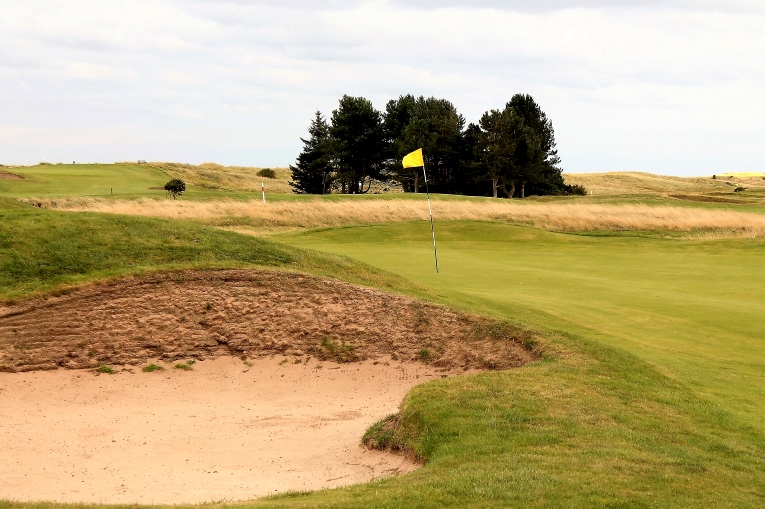
Shifting backdrops enhance the playing experience. This copse of trees in the background was planted in the 1960s.
Tenth hole, 420 yards, Lang Whang; Wind is an obvious factor yet what does it mean to proclaim Goswick as a course that plays well in the wind? Look no further than the tenth hole green complex. Great architecture tends to promote – and even encourage – bold play. Seeing a well-struck low iron clear the bunker below, race onto the green, take the bank at the back and retreat to nestle close to the hole is pure joy.

A large bunker some 40 yards short right of the green works in perfect concert with a small bunker front left and the tightly mown rear right mound to create challenges – and opportunities – for players of all caliber.
Eleventh hole, 560 yards, Goswick; The longest hole on the course is also one of the most interesting, a neat feat that rarely happens. Two things make it so: the most humpy-bumpy fairway, bobbing up and down like a roiling sea, is sandwiched between out of bounds right and a burn left and there’s a proper cross hazard, completely encased in short grass, 60 yards short of the green. Herbert Fowler, the great English architect, made famous by such bunkers at Walton Heath, would be proud of this old-fashioned, timeless, confrontational hazard.
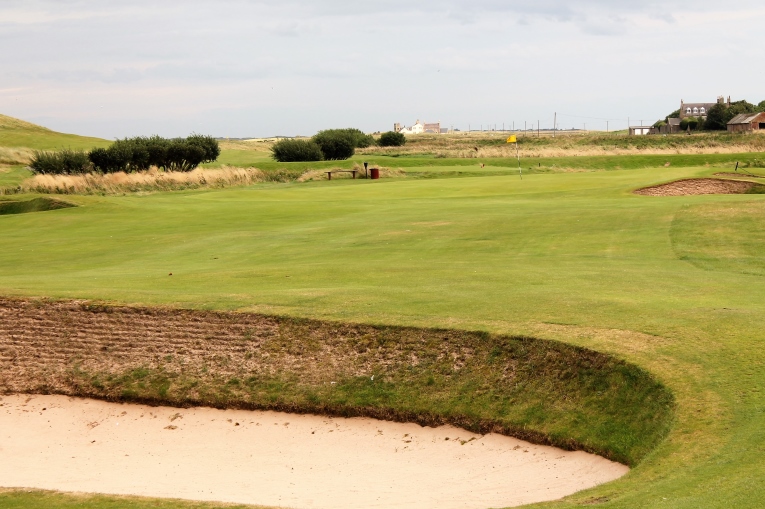
If either of the first two shots don’t go according to plan, this fairway bunker 60 yards shy of the green looms large.
Twelfth hole, 365 yards, Pilgrim’s Way; On the most adventurous hole on the course, the tee ball is played over the burn on a diagonal to a billowing fairway, which is bisected by a dune for fifty yards some 255 yards from the tee. An ideally positioned ball, right center, provides a good view of the green but those golfers that steer a bit more conservatively to the left often face a blind approach.
Thirteenth hole, 200 yards, Lough; An obvious hole to build, the tees are benched into the dominant dune line and the green is placed two hundred yards ahead in the most intoxicating direction. If the twelfth doesn’t convince the player of this being an ‘end of the world’ course, then this hole will.
Fourteenth hole, 395 yards, Dune; Three fairway bunkers make this one of the most precise driving holes on the course. Nonetheless, the more enchanting shot is the approach to a green nested in the dunes. A true links connoisseur will (eventually) sort out a way to use the tight grass on the right side of the green complex to his maximum advantage. With so much tight grass right, silly is the golfer who visits the solitary left greenside bunker. Why this hole isn’t more heralded is a mystery.
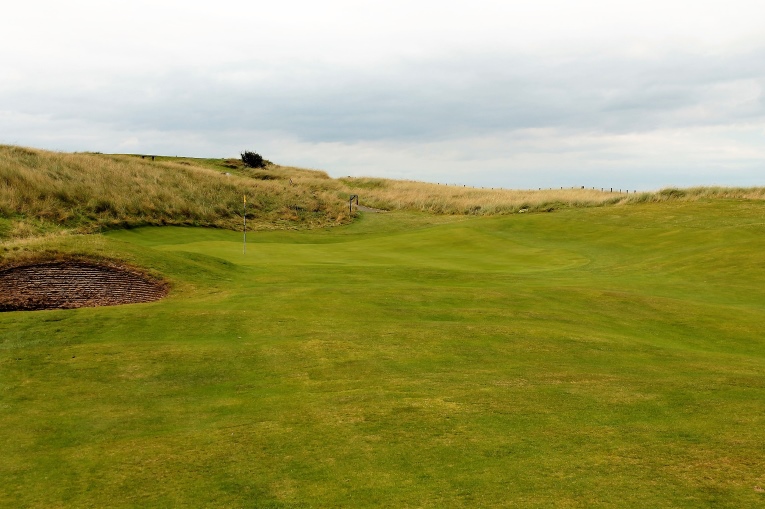
The high sweep of tight grass to the right is another example of the club and greenkeeping staff getting the details correct. If the bank was thick grass, so much fun would be snuffed out of the approach.
Fifteenth hole, 150 yards, Bide-a-Wee; More times than not, downhill one-shotters feature better views than golf because the green is bland relative to the quality of the scenery. Not here – this green features the most slope and contour of any on the course.
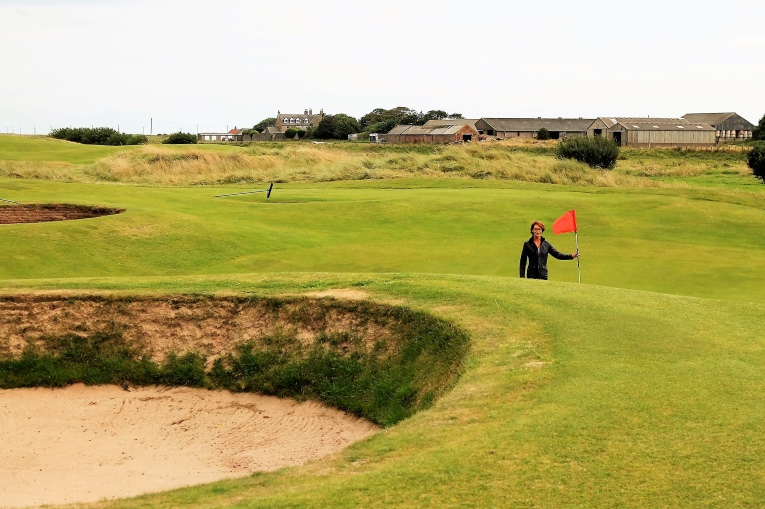
This five foot eight inch lady provides perspective as to the punchbowl nature of the front half of the green.
Seventeenth hole, 520 yards, Stonehenge; Its tee high on the dune affords a clear view of the distant clubhouse, a very agreeable sight and one that doesn’t happen often on penultimate holes (Sunningdale Old being an obvious exception). Three bunkers that bifurcate the fairway 160 yards from the green are also clearly visible and clearing them in two is contingent upon a good drive. It’s worth highlighting that each of the four par 5s enjoys support from various members as being the course’s best three-shotter. Not many links can claim the same!
In searching for flaws, some people cite the closing hole on each nine. The ninth is a 200 yarder and the Home hole is a 270 yarder played from an elevated tee. Critics sniff that the holes feel ‘jammed in.’ That opinion may be exacerbated by the expansive views afforded on so many of the other holes. In each hole’s defense, the ninth is undeniably sturdy and it has a feature that the author enjoys: out of bounds lurks just a few paces from the back right edge of an angled green. Hats off to the player skilled enough to successfully chase after back hole locations, especially in the hole’s typical right to left cross breeze. Regarding the Home hole and its nine bunkers in a span of 50 yards, the worst thing that can be said is that doesn’t feel like any other hole on the course. As a 1/2 par finisher in the tradition of North Berwick, Prestwick and Kilspindie, anything can happen, especially here as it tempts good players into dumb decisions. Coming up short in one of the revetted bunkers might actually be preferable to going long, from where even professionals routinely card an aggravating 5. The author favors such a risk/reward hole far ahead of dullish, standard fare two-shotters.
In Volume 1 of The Confidential Guide, I wrote that England is ” ... my favorite country in the world for golf.” Goswick Golf Club is further validation of that sentiment. No other course of its class is within an hour’s drive, so list-checkers aren’t prone to include it on their mad dash trips. It’s their loss. How improved might our lives be if we could play here on a regular basis?! Give the founding members kudos for following Dunn’s suggestion and selecting the remote site that set a path for future generations to expand the course in an intelligent manner while keeping it cocooned in nature.




